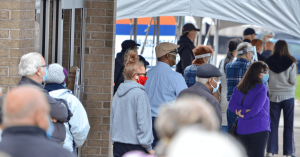It has been roughly 10 months since our first COVID-19 lockdown in Ontario, and case numbers are worse than ever. Social distancing, restrictions on businesses and more lockdown orders have been put in place, but during these winter months they do not seem to be helping. Many are feeling hopeless and are wondering “what more can be done to combat the spread of COVID-19?” The Ontario government’s only response has been to close businesses, schools and other sites that are transmitting the virus. Are there other solutions to augment this?
OSPE and its engineers believe there is a key piece to our defence against this virus that has not been properly addressed by the Ontario government – the need for proper ventilation and air filtration to stop the spread of the virus via infected aerosol particles in the air.
 Back in August, before schools reopened, we published a blog wondering how safe schools would be once classes were back in session. During this time, the focus for transmission was still on person-to-person contact, COVID “droplets,” and close contact with infected surfaces or people. Clearly combatting these means of infection could only do so much, as we have seen a number of outbreaks occur in schools since students returned to classes in person.
Back in August, before schools reopened, we published a blog wondering how safe schools would be once classes were back in session. During this time, the focus for transmission was still on person-to-person contact, COVID “droplets,” and close contact with infected surfaces or people. Clearly combatting these means of infection could only do so much, as we have seen a number of outbreaks occur in schools since students returned to classes in person.
Since then, both the World Health Organization and the Public Health Agency of Canada have recognized the spread of COVID-19 transmission via airborne aerosol particles; however, Public Health Ontario (PHO) seems less convinced. PHO does recognize airborne transmission as a possibility but states that it is unlikely and only possible “during prolonged exposure in a poorly ventilated space.”
OSPE believes that airborne transmission is one of the main reasons why we are seeing so many outbreaks in schools and long-term care facilities across the province. With outdoor temperatures dropping, many of these buildings have shut themselves off from fresh air that would have helped get rid of these COVID aerosol particles. Instead, many of these buildings have closed HVAC systems that recirculate the same, potentially infected, air.
 Earlier this year, the American Society of Heating, Refrigeration & Air-Conditioning Engineers (ASHRAE) published their report, ASHRAE Position Document on Infectious Aerosols, which summarizes their findings on the effectiveness of proper ventilation and filtration on the spreading of infectious aerosols. What they found was that “…HVAC systems can have a major effect on the transmission [of infectious diseases] from the primary host to secondary hosts. Decreasing exposure of secondary hosts is an important step in curtailing the spread of infectious diseases.” To read the full report, click here.
Earlier this year, the American Society of Heating, Refrigeration & Air-Conditioning Engineers (ASHRAE) published their report, ASHRAE Position Document on Infectious Aerosols, which summarizes their findings on the effectiveness of proper ventilation and filtration on the spreading of infectious aerosols. What they found was that “…HVAC systems can have a major effect on the transmission [of infectious diseases] from the primary host to secondary hosts. Decreasing exposure of secondary hosts is an important step in curtailing the spread of infectious diseases.” To read the full report, click here.
OSPE is calling on the Ontario government to immediately address the airborne transmission of COVID-19 to help slow the spread of the virus. OSPE still believes that social distancing and proper hygiene are also incredibly important but believes that adding extra precautions for airborne transmission will only help our defence against this deadly virus.
Other groups have already voiced their concerns to the government, and after careful consideration of the evidence, we are reaffirming our position. In fact, OSPE believes consulting with engineers, scientist, HVAC specialist and other experts in these fields should be done immediately in order to help the Ontario government adequately address this issue before more outbreaks occur.






Pingback: Fighting COVID with Ventilation | James Andrew Smith
I agree. More attention is needed to provide recommended levels of ventilation. Is there a way for building owners or users to check on ventilation performance ? Would monitoring CO2 levels help?
We have a CO2 monitoring device. At what level of indoor vs outdoor CO2 become an indicator of inadequate ventilation?